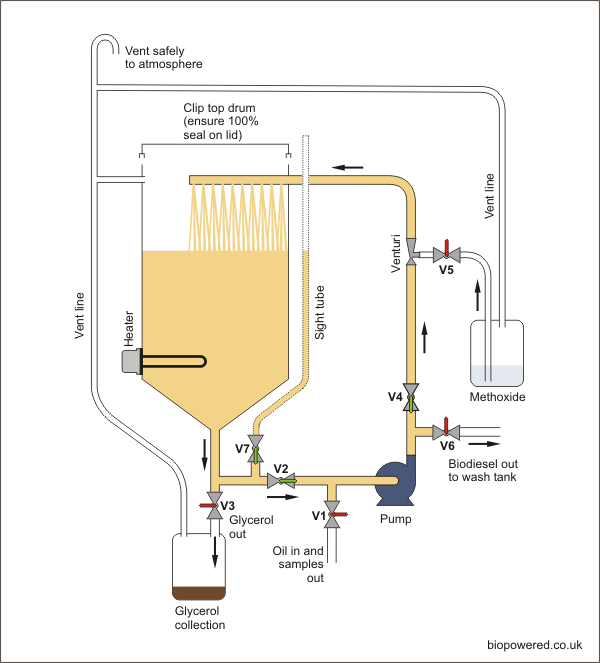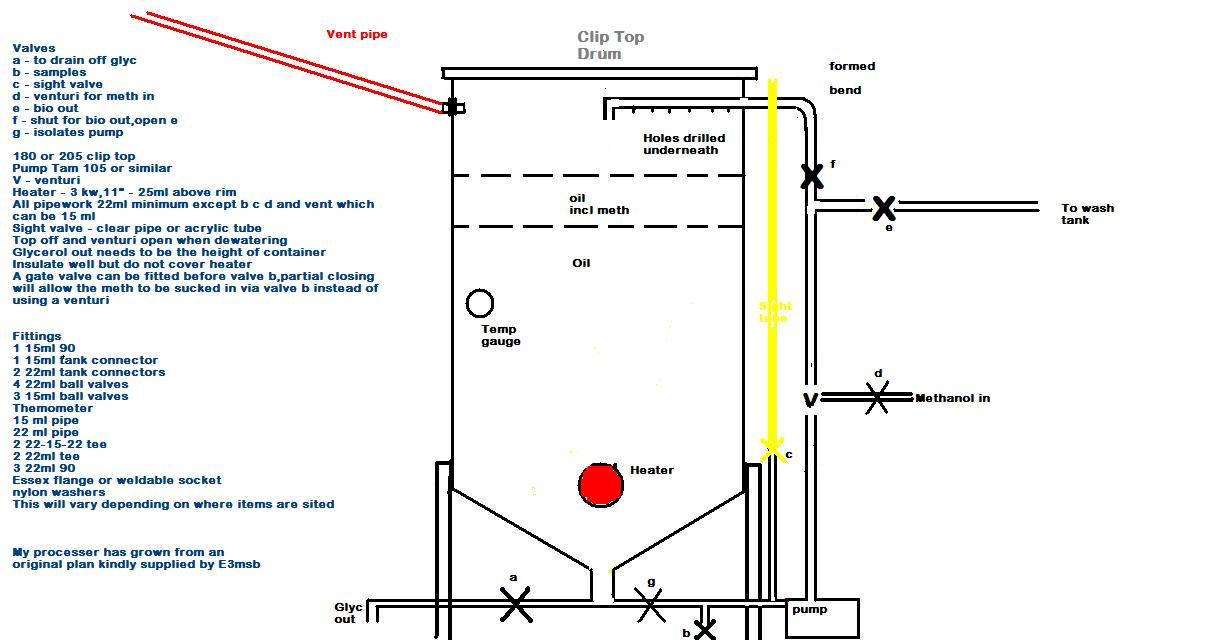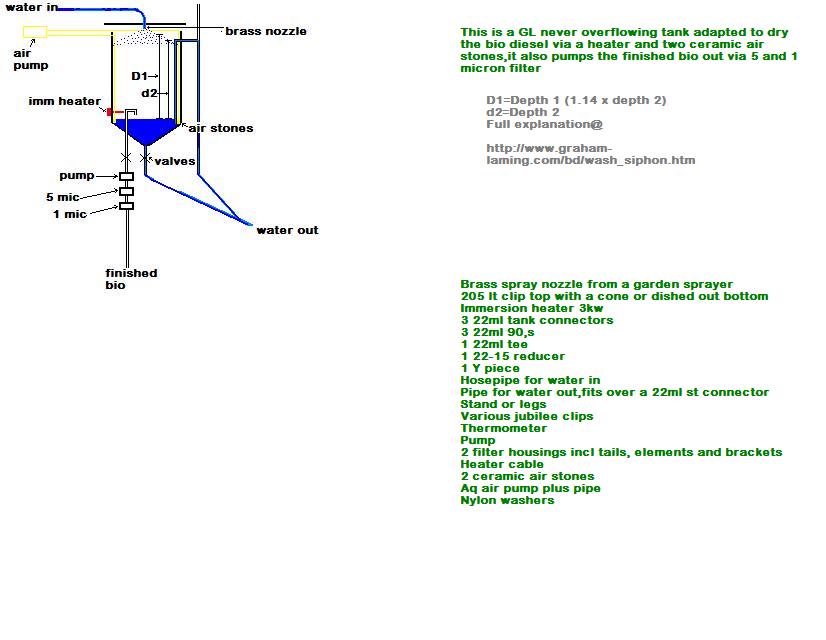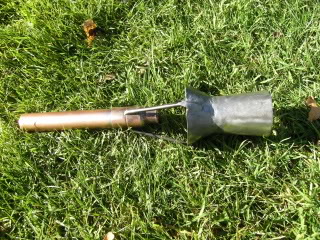Difference between revisions of "Processor - basic design"
(→State diagram) |
(→State diagram) |
||
| Line 99: | Line 99: | ||
<td>[[#Step5| Add methoxide]]</td> | <td>[[#Step5| Add methoxide]]</td> | ||
<td></td> | <td></td> | ||
| − | |||
<td bgcolor=#84C326></td> | <td bgcolor=#84C326></td> | ||
<td></td> | <td></td> | ||
| + | <tdbgcolor=#84C326></td> | ||
<td></td> | <td></td> | ||
<td bgcolor=#84C326></td> | <td bgcolor=#84C326></td> | ||
Revision as of 12:04, 27 December 2010
This is probably one of the least complicated processor designs and is suited to those new to Biodiesel production and is similar to the Appleseed processor used extensively in the USA. It can, by quite simple modification, later be upgraded with additional equipment to speed the process and could if required be converted into a GL processor. This design requires a wash tank and a separate Methoxide mixer. The wash tank shown is based on a design by Graham Laming, with some minor additions.
Contents
Basic design
As with all processors employing an electrical heater, it is strongly recommended that the heater is interlocked with a processor level switch or that a non siphoning, in-line heater is used.
A 5% water pre-wash can be used with this processor design, but it probably offers little benefit as the design requires additional water washing. It is preferable to retain the glycerol, uncontaminated by water, and use it to Glycerol wash the subsequent batch.
To further simplify the design, the venturi could be dispensed with and the Methoxide introduced via valve V1, using the suction created by the pump. This method should be carried out very slowly and with great care, as running high concentrations of Methoxide through the pump could be dangerous. For the little cost and effort involved it is far preferable to fit a venturi.
Operating procedure
State diagram
This table tells you about the status of each valve, the heater and pump at various stages of the process.
State diagram: Green = valve open, pump running or heater on.
| Step | Heater | Pump | V1 | V2 | V3 | V4 | V5 | V6 | Notes |
| Oil in | Pre-filter oil. Ensure pump is primed. | ||||||||
| Heat oil | 70 -90°C | Remove processor lid. Only heat to 60°C if Glycerol washing, see state separate diagram. | |||||||
| Dry oil | 70 -90°C | Drain any settled water via V1 before starting pump. Disconnect V6 from methoxide container so venturi can draw air. | |||||||
| Cool oil | Allow to stand until oil reaches reaction temperature of 64°C. | ||||||||
| Add methoxide | Replace reactor lid and ensure it seals completely. | ||||||||
| Reaction stage | React for about 1½ hrs or until 3/27 pass is achieved. | ||||||||
| Optional 5%water pre-wash | If required 5% water pre-wash can be carried out at this stage, see additional state diagram below. | ||||||||
| Settle glycerol | Circa 1hr | ||||||||
| Drain glycerol | Crack open valve V3 and slowly drain Glycerol. | ||||||||
| Transfer to wash tank | See separate state diagram for wash procedure |
Step 1, Oil in
Possible additional modifications
Higher performance pump
The basic design employs typically a TAM 105 or a Leo XKM60 based on an 80 - 100 litre batch size, but a pump with a capacity of around 100 – 150 litres/min. could be used giving a reduction in processing time
Low oil level interlock
The one flaw with this design of processor is the possibility of running the heater, part of which is exposed above a low liquid level. Two methods of preventing this have been introduced, both of which interlock with the heater to prevent it being switched on when the oil in the processor is below a predetermined level.
Non siphoning, in-line heater
Devised by Graham Laming, this unit comprises a small tank fitted with flow and return ports and housing a heating element. It is designed in such a way that liquid is trapped in the tank even when the system is drained. They remove the need for an in-tank heating element but are not in themselves fool proof. See In-line heater.
Mixing eductor
This is a devise mounted inside the processor operating on the venturi principal and driven by the existing pump. It creates a turbulent circulation within the tank and significantly reduces processing times. See Mixing eductor.
PID temperature controller
Instead of using the thermostat built into immersion heaters many users are now employing PID controllers. These units control to a far greater accuracy, without hysteresis, and across a broader temperature range. See PID controller
Fill processer to required level,turn on pump and heater and circulate with lid off and venturi open (if applicable) until required temperature is reached (70 – 90 C ) Replace lid and settle overnight then drain off any water,perform a hot pan test to verify the oil is dry Titrate and set level,turn on heater and pump until 64C is reached,turn off heater and introduce methoxide via pump or venturi Circulate for x amount of time (x will depend on pump size,typically ½ hour – 1 ½ hours ) Perform 27/3 or 5/45 test at 20C continue circulating until a pass is achieved Prewash – if required Slowly add 7% water and ciculate for 15 minutes Close bottom valve and settle for at least 1 hour then drain glycerol Transfer to wash tank Wash until water is clear,perform 50/50 soap test to confirm Allow to settle for 1 hour then drain water,turn on heater (optional) and airstones and bubble overnight to dry Pump through chosen filters to holding tank Instead of drying the wvo by heat and circulation you can perform a glycerol prewash which will also lower the titration value Fill processer to required level turn on heater and pump then heat to 60C Turn off heater and add 20% glycerol,circulate for ½ hour then settle for 1 hour before draining off glycerol Titrate as normal You can speed up your processing times by adding things like an eductor
From a safety point of view i would recommend fitting a float switch or an inline heater so that the heater cannot be turned on unless it is covered



